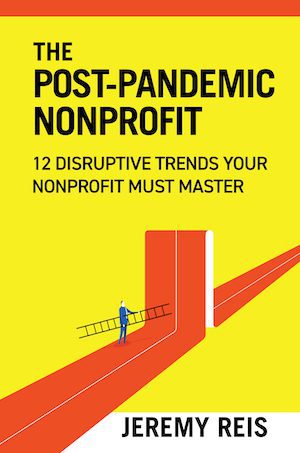How Can My Nonprofit Thrive After the Pandemic?

The Post-Pandemic Nonprofit is an insightful look into 12 disruptive trends that will impact nonprofit organizations during and after the pandemic. For each trend, nonprofit leaders will learn what is happening and what they will need in order to take advantage of the trend and eliminate downside risk. Thorough research and examples of nonprofit organizations and the trends impacting them informs readers about the steps they must take to not only survive but also thrive through the pandemic and economic recession.
The 12 Disruptive Trends
After the pandemic, nonprofits must operate from a solid foundation. I call this necessity “renewing our roots.” This chapter explores how to position the organization during lean times to take advantage of the post-pandemic environment.
A fundamental question many nonprofits are asking right now is: Is our organization doing the right things? In this chapter, we explore how to examine your strategic initiatives, focus on your performance, conserve cash with intelligent cost-cutting, and explore mergers and restructuring.
Many of us were caught without a clear plan on addressing the variety of problems the pandemic presented, identifying which risks were clearly an issue we needed to handle, or the tools to estimate the risk involved. In this chapter, we’ll explore how nonprofits are rediscovering risk management.
During this pandemic crisis, the novel solutions nonprofits have created are resourceful and creative. Organizations shifted operations online, developed ways to deliver services in a no-contact world, and pivoted to provide complementary services to people with the greatest need. But our innovation isn’t finished! The nonprofit of the future will find new ways to reach beneficiaries while creatively raising funds.
Many of our organizations were forced through lockdowns to institute remote working. There are challenges to maintaining a virtual team, but remote working is a trend nonprofits must address during and after the pandemic. Not all staff are going to want to return to the office full-time, so what will the workplace of the future look like?
Even after much of the pandemic has decreased in risk, nonprofits will face a trend of continuing to safeguard interactions to prevent the spread of other diseases, colds, and viruses; ultimately, we may not be able to eliminate the COVID-19 virus entirely.
The flexible nonprofit survives. The pandemic demonstrated to many nonprofit organizations the need for more nimble programs. When an organization designs, or even reinvents, a program to scale up or down, it provides the necessary flexibility to deal with unpredictable funding.
After the pandemic started, most countries implemented controls on the free movement of people and goods across borders. These restrictions negatively impacted nonprofits that enjoyed such movement of staff and goods. Unfortunately, we are unlikely to return to the pre-pandemic state of free movement in the next several years.
There are no guarantees in what the short-term future looks like. If a global economic slowdown begins for several years, nonprofit organizations will face funding challenges like never before.
Organizations are adapting and innovating in this challenging environment. They adapt by creating virtual options for fundraising, staff interactions, and meeting the beneficiaries’ needs.
For many donors, volunteers, and employees, transparency is the key to winning their support. These supporters want easy access to your financial data and an understanding of how you do your work. A transparent nonprofit shares this information in a way that is easy to absorb and act upon.
Savvy nonprofits are deploying AI tools to improve donor service, help more people, enhance the donor experience, and automate previously manual processes. After the pandemic, your organization should review how it can implement AI tools to improve operations.
Get the First 3 Chapters
Nonprofits are being disrupted by changes in technology, the economy, and social norms. Yet most nonprofits don’t have a plan to thrive during the pandemic or economic recession because they are focused on surviving day-to-day operations instead of planning for long term growth and sustainability. To survive this new era of disruption, nonprofit leaders must be able to understand how these trends will affect their organization and what steps they can take now to ensure that they can continue serving their communities when times get tough.
In The Post-Pandemic Nonprofit, author Jeremy Reis provides a detailed look into 12 disruptive trends that will impact nonprofits in the near future (and beyond). For each trend you will learn what is happening with it as well as why your nonprofit needs to pay attention to it so you can prepare yourself for its effects before disaster strikes. Each chapter also includes an action step for nonprofits looking to implement change within their organizations. Get a free preview of the book!
About the Author
Jeremy Reis is the Sr. Director of Marketing for World Concern, a relief and development organization working in 15 countries. At World Concern, he manages the team responsible for marketing, communications, direct mail and digital fundraising. Previously, Jeremy served at Food for the Hungry for eight years managing the team responsible for marketing, sports and mainstream artist partners, direct mail, and digital fundraising.
In his latest book, The Post-Pandemic Nonprofit, he shares insights to help your nonprofit thrive in an uncertain world.
Jeremy is on the Advisory Council for Christian Leadership Alliance where he serves as a member of the strategy leadership.
Jeremy’s worked in a variety of corporate, consulting, and nonprofit roles. He started his career on the tech side and after finishing his MBA at The Ohio State University, jumped over to marketing with nonprofits. He understands and speaks fluent geek, while being able to translate real business needs into actionable plans.
Jeremy is the author of The Post-Pandemic Nonprofit, Raise More Money with Email, and Magnetic Nonprofit. Jeremy blogs at NonprofitDonor.com and is the host of the Nonprofit Answers podcast.
Jeremy lives near Franklin, Tennessee with his wife Jennica and nine children.
